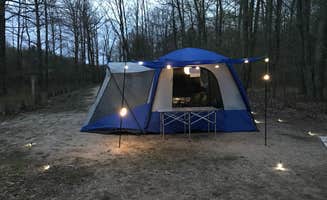Dispersed camping near Prescott, Michigan primarily centers around the Huron-Manistee National Forest, which spans over 978,000 acres of public land. The forest consists of mixed hardwoods and pines with elevation changes uncommon for Michigan's lower peninsula, creating diverse camping options along ridgelines and waterways. The area experiences distinct seasonal changes with summer temperatures averaging 70-85°F and winter temperatures often dropping below freezing.
What to do
Hiking and backpacking: The North Country Trail and Manistee River Trail form a popular 20-mile loop through the forest. "We walked this trail for 5 days and 4 nights. Cell service was spotty, which was the goal. Lots of wildlife and great views. You need to carry everything out that you carry in," notes a camper at Huron-Manistee National Forest.
Water activities: Rivers and streams throughout the forest offer swimming and paddling opportunities. The dunes along the river create unique recreational settings. "The dunes along the river seem out of place, and wonderfully so. You could spend so much time here, climbing around, swimming, kayaking, and enjoying the views," explains one visitor.
Wildlife viewing: The forest habitat supports diverse animal species observable throughout the seasons. "Lots of wildlife" is commonly reported by backpackers, with dawn and dusk offering the best viewing opportunities along less-traveled sections of the trails.
What campers like
Maintained trails: Campers appreciate the well-marked routes and maintained pathways. "The trails are always so maintained, the sites are easy to find and always marked. Definitely one of my favorites!" shares a regular visitor to Huron-Manistee National Forest.
Riverside and ridgetop camping options: The terrain provides varied camping experiences. "As the trail both runs above and along the Manistee river with each mile, you have ample opportunity to camp both ridge-side and river-side. Do what I did and spend one night at the riverbank and one on a hilltop and you'll have the best of both worlds," suggests a backpacker.
Solitude and space: Dispersed sites offer privacy rarely found at developed campgrounds. "The nearest other campers were not within earshot nor could we see them," notes a backpacker, highlighting the spacious nature of backcountry camping in the region.
What you should know
Water sources: Streams provide water but require treatment. "Water is stream is probably safe but bring a filter or enough water to last," advises a backpacker at Huron-Manistee National Forest.
Navigation and planning: The forest size requires preparation. "Use a GPS system or a program to ensure you are not in private property. Have at least 3 sites as possibilities," recommends an experienced camper who specifically enjoyed camping at Government's Landing.
Seasonal considerations: Weekends during summer months see increased traffic on trails and at prime sites. "Beautiful but busy" is how some describe peak season, while spring and fall offer more solitude but require additional weather preparation.
Tips for camping with families
Multi-generational trips: The area accommodates family groups with varying experience levels. "We had 11 Grandkids with us, and we had 9 backpacking tents. The children all carried their own tents, sleeping bags, and food for 4 days. The River trail supplied us with our water needs for cooking and drinking, from the Manistee River. It was a fun trip for all," shares a family group leader who stayed at Huron-Manistee National Forest.
Pack weight distribution: Children can carry appropriate gear to build skills and confidence. One family reported having children "carry their own tents, sleeping bags, and food" during multi-day excursions, adapting pack weights based on age and ability.
Educational opportunities: The varied ecosystems provide natural learning environments. Families report incorporating plant identification, water testing, and wildlife tracking into their camping activities to engage children with their surroundings.
Tips from RVers
Site selection for larger vehicles: RV access varies significantly between locations. Cut River Dispersed Campsite accommodates larger rigs with fifty-amp hookup capabilities, though without standard amenities like toilets or water connections.
Self-contained preparation: RVers must arrive with all essential supplies. The sanitary dump station serves as the only waste management infrastructure at Cut River, requiring campers to properly manage all other waste during their stay.
Clearance considerations: Access roads to dispersed sites often present challenges for longer vehicles. Scouting potential locations before attempting access with larger RVs is recommended, especially after rain when forest roads may become difficult to navigate.


